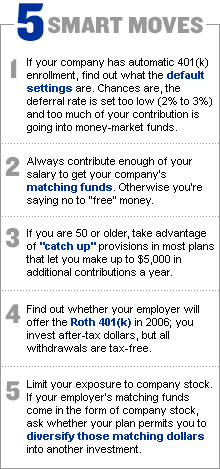|
How to fix your 401(k)
We shed some light on new features aimed at making plans easier to use.
NEW YORK (FORTUNE) - Many of the 76 million baby boomers who will downshift into retirement over the next two decades are woefully unprepared, thanks at least in part to the challenges that come along with most 401(k) plans. More than half of today's 55-year-olds have less than $50,000 in their defined-contribution plans, according to research from McKinsey & Co.
Says Alicia Munnell, a Boston College professor and author of Coming Up Short: The Challenge of 401(k) Plans: "These plans have shifted all the responsibility and risk from the employer to the individual, and people make mistakes every step of the way. Even I do." To help employees do better, companies large and small are recasting their plans. But even though the changes are designed to simplify your life, they can be daunting to digest. Here's a guide to the latest developments. Auto sign-up
Participation rates for 401(k) plans reached a plateau of around 75 percent 10 years ago. And less than half of eligible workers in their twenties participate, according to benefits giant Hewitt Associates. The answer? Automatically enroll employees, which 19 percent of big companies already do -- among them Hewlett-Packard (Research), J.C. Penney (Research) and Motorola (Research). An additional 28 percent say they plan to add this feature soon. Once enrolled, employees can choose to drop out, but few do. Less is more
Simply getting employees to start setting aside money for retirement, though, is not enough. An alarming percentage of participants put too much money into money-market and bond funds, which seem safe but almost guarantee that you won't earn enough to retire on. Part of the reason for that excess of caution seems to be too much choice. When 401(k) plans first crawled out from an obscure section of the Internal Revenue Code in 1981, they offered a bare-bones menu of investments. Over time, employers started providing additional options. But choice taken to the extreme can have a paralyzing effect. A study by Columbia University professors Sheena Iyengar and Wei Jiang found that participation in 401(k)s dropped 2 percent for every 10 options offered. And as the number of mutual funds increased, participants were more likely to stash their cash in money market and bond funds—a phenomenon Iyengar and Jiang call "extremeness aversion." Plan sponsors have finally recognized that less is more, and in 2005 the average number of investment options offered (14) did not rise for the first time since Hewitt began analyzing plans. The one-fund solution
Those investment options increasingly include all-in-one lifestyle funds, which hold a mix of stocks and bonds based on the participant's age or risk profile. This mix is rebalanced over time, so financial advice is essentially embedded in the product. Lifestyle funds emerged in the mid-1990s but have exploded onto the scene of late: Fidelity's lifestyle fund family, dubbed Freedom, is now available in 78 percent of the plans it administers, up from 51 percent in 2001. Management fees are not that steep either—in fact, in May, Fidelity nixed the 0.08 percent fee it had charged for the Freedom funds. At the Chrysler Group (Research) in Auburn Hills, Mich., senior retirement and savings manager Jim Bante has added five lifestyle fund portfolios. But only 14 percent of the plan's 80,000 participants have taken advantage of them so far. Advice is up
If auto-enrollment and lifestyle funds don't do the job, companies like Chrysler can choose to bring in the pros. Professional, third-party management of 401(k) plans is an even hotter trend than auto-enrollment, according to David Wray, president of the Profit Sharing/401(k) Council of America. According to Hewitt, 37% percent of plan sponsors offer third-party investment advisory services, which can include online advice or one-on-one counseling, up from 18 percent in 2001. Chicago-based ProManage, one of the first firms to hang out a shingle in this arena seven years ago, will probably double its assets under management to $12 billion by next December, according to CEO Carl Londe. What ProManage offers clients is a "lifestyle fund on steroids," according to Lori Lucas, director of participant research at Hewitt. While lifestyle funds come from just one family of funds, like Vanguard, ProManage can run the gamut of investment options and better tailor an option for employees. An expensive expertise
Of course, all this expertise comes with a price—one that's too steep for several retirement gurus. "The big issue is, What are you getting, and what is the cost?" says industry pioneer Ted Benna, who designed the first 401(k) plan in 1981. "I'm seeing costs [for advice] ranging from 100 to 150 basis points on top of all the other fees, which is a tough hurdle to overcome. I'm not convinced that there is enough added value versus just doing lifestyle funds." Chris McNeil thinks it's worth it, though. McNeil, benefits director at New England retail chain Jordan's Furniture, brought in 401(k) Toolbox, a service from investment advisor PMFM, which offers Jordan's employees daily management of their accounts at a cost of 1.25 percent of assets. Of Jordan's 1,350 employees, 100 have signed up since it was launched in June. Avoiding company stock
Discouraging employees from holding company stock is a key goal of 401(k) reformers. Despite the meltdowns of Enron and WorldCom, which highlighted the dangers of investing in the same company that signs your paycheck, company stock still constitutes too large a portion of most 401(k) balances, experts say. In plans that offer company stock, about one in four employees have half or more of their total 401(k) balance invested in it, according to Hewitt. The most effective way to address the problem? Just say no. This year Hewitt found that only 43 percent of big companies offered their own stock, down from 55 percent in 2001. Another pitfall is that so many employees fail to roll over their balances when they switch jobs. More than half of participants (55.2 percent) cashed out lump-sum distributions when they changed jobs, according to the Federal Reserve's 2001 Survey of Consumer Finances. Some of those cashouts were cases where departing employees with small balances give no instructions, and employers simply wrote them checks—a process known as a "force out." New regulations from the Department of Labor make it harder for employers to close small accounts. Getting the word out
Of course, these changes won't have much impact if nobody knows about them. And some benefits managers continue to use outdated, boring, and downright confusing methods of communicating with plan participants. Boston College's Munnell, no financial slouch herself, recalls getting a letter from her employer about her 401(k) that even she couldn't decipher. To improve the flow of information, some companies are now targeting specific groups of employees (nonparticipants, those 55 and older) with tailored messages. Chrysler used animated e-mails with fireworks and money falling from the heavens to boost plan participation last year. Sometimes a simple seminar can wake people up to what they're missing. As more companies institute much-needed changes, expect more great awakenings in the months ahead. ________________
For more personal finance, click here. |
|



